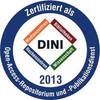German Title: Der Einfluss von mechanischen Kräften auf die Endothelzellentwicklung
Preview |
PDF, English
- main document
Download (3MB) | Terms of use |
Abstract
Mechanical forces are vital for the development and maintenance of endothelial cells. However, how tensile forces or extracellular matrix stiffness affect differentiation of endothelial cells during embryogenesis is largely unexplored. In my dissertation, I applied non-cyclic uniaxial stretch on differentiating mouse embryonic stem cells and used materials with different stiffness, like laminin, matrigel, gelatine and poly-l-lysine, to study the interplay between these distinct types of mechanical forces on endothelial cells. Using flow cytometry analysis, immunofluorescence stainings and quantitative expression analysis, I identified key functions of stretch and matrix stiffness in triggering gene expression program facilitating endothelial cell development and differentiation. I found that application of non-cyclic uniaxial stretch for 2 hours at early developmental stages, such as stem cells, mesodermal precursors and cardiovascular precursors, was sufficient to significantly increase endothelial cell numbers, while application of stretch at later stages was not beneficial. Differentiation of embryonic stem cells on laminin strongly promoted endothelial cell differentiation, similarly on matrigel, although to a smaller range. However, the differentiation on gelatine and poly-l-lysine did not increase endothelial cell numbers. To study the interplay between matrix stiffness and tensile forces, I analysed endothelial cell numbers in differentiating embryonic stem cells subjected to stretch at different stages and cultured on different matrices. Interestingly, I found that application of mechanical stretch on cells cultured on a soft matrix, e.g. matrigel, did not enhance endothelial cell differentiation, while application of the same stretch strength on cells cultured on a stiffer matrix, e.g. gelatine, resulted in significant increase in endothelial cells. To study the molecular mechanisms behind the enhanced endothelial cell differentiation, I performed RNA-sequencing analysis. I identified key genes involved in endothelial cell and vascular system development to be highly upregulated upon application of stretch even after a short period of time (2 hours), such as Vegfa, Fgf7, Igf1. In summary, my work suggests a tight interplay between tensile forces and extracellular matrix stiffness during endothelial cell development and differentiation and identified critical factors involved in this process.
| Document type: | Dissertation |
|---|---|
| Supervisor: | Dobreva, Prof. Dr. Gergana |
| Place of Publication: | Heidelberg |
| Date of thesis defense: | 6 March 2025 |
| Date Deposited: | 08 Aug 2025 07:04 |
| Date: | 2025 |
| Faculties / Institutes: | Medizinische Fakultät Mannheim > European Center for Angioscience |
| DDC-classification: | 570 Life sciences 610 Medical sciences Medicine |
| Controlled Keywords: | Endothelial Cell, Extracellular Matrix, Stretching |









